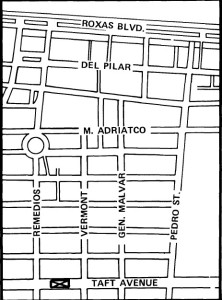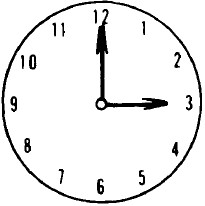OBJECTIVES
At the end of this module you will be able to perform the following tasks in Pilipino:
- Ask for and understand directions.
- Say “I don’t understand” and “Please, repeat.”
- Ask about distance (far, near).
- Understand Pilipino and Tagalized Spanish numbers (1-60) used to state distances (in terms of kilometers, streets and time).
- Express your thanks to someone who has helped you.
Audio for this lesson
Paano po ba ang pagpunta sa istasyon ng bus?
How Does One Get to the Bus Station?
| Bob: | Mamà, maaari po bang magtanong? | Mister, may I ask a question? |
| Tao*: | O0, puwede. Ano iyon? | Yes, you can. What is it? |
| Bob: | Paano po ba ang pagpunta sa istasyon ng bus? | How does one get to the bus station? |
| Tao: | Sa kantong ito, kumanan ka. Dumeretso ka hanggang sa Rizal Avenue. Sa kaliwa mo, makikita mo ang istasyon ng bus. |
At this corner, turn right. Go straight ahead to Rizal Avenue. On your left, you’ll see the bus station. |
| Bob: | Hindi ko po naiintindihan. Pakiulit po ninyo. | I didn’t understand. Please repeat, sir. |
| Tao: | Sa kantong ito, kumanan ka. Dumeretso ka hanggang sa Rizal Avenue. Sa kaliwa mo, makikita mo ang istasyon ng bus. |
At this corner, turn right. Go straight ahead as far as Rizal Avenue. On your left, you’ll see the bus station. |
| Bob:. | Gaano kalayo rito ang istasyon? | How far from here is the station? |
| Tao: | Mga sampung minuto sa dyip. Mabuti pa magdyip ka. | About 10 minutes by jeepney. It would be better to take the jeepney. |
| Bob: | Marami pong salamat sa tulong ninyo. | Thank you very much for your help. |
| Tao: | Walang anuman. | Don’t mention it. (It’s nothing.) |
| *Tao – person | ||
NOTES ON THE CONVERSATION
Mamà is a polite term used to address a man whose name you don’t know. Notice that the mark over the “a” indicates that the vowel is cut short or stopped; it is not a stress mark.
Maaari is sometimes used instead of puwede. Both mean “can” or “may.”
Kantong is kanto (“corner”) plus the linker -ng.
Makikita–future of makita–“will be able to see.”
Mo is “you” or “your.” Sa kaliwa mo, “On your left”; Makikita mo … , “You will see … ” (See below for a summary of Pilipino pronouns.)
Pakiulit is paki (prefix for polite request) and ulit (“to repeat”)–“Please, repeat.”
Hanggang means “until,” “as far as,” or “to.” Hanggang bukas, “until tomorrow,” is commonly used when parting from someone you expect to see the next day.
Dyip (“jeepney”) is an ornately decorated, elongated jeep used as a jitney. Jeepneys have routes like buses, but except in Manila do not have regular stops; the driver will stop whenever requested. You just say Para po!; the destination is painted on the side. In some places the jeepneys are also color and number coded.
Magdyip means “to take a jeepney.” Mag added to a noun changes it to a verb; for example, asawa – “spouse”; mag-asawa – to get married.” Mag is often used with foreign words: mag sweater – “to put on/wear a sweater”; magbus – “to take/ride a bus.”
PRONOUNS
One pronoun in Pilipino may have several meanings in English, as you saw in the examples Sa kaliwa mo, “on your left,” and Makikita mo” “you will see.”
Different pronouns in Pilipino may have only one English equivalent; for example, asawa ko and aking asawa both mean “my spouse.”
Every pronoun in Pilipino has three forms, classified as the ang, ng, and sa forms. The form of the pronoun often depends on its position In the sentence.
- As you know, ang in front of a noun marks it as the topic of a sentence, so the pronouns that are used as topics are called the ang forms.
Examples:
| I | ako | Tatlong buwan na ako rito. (I have been here three months now.) |
| You | ka/ikaw | Kumusta ka? (How are you?) |
| We (I and others) | kami | Hindi kami makapagtatagal. (We can’t stay longer.) |
| We (You & I & others) | tayo | Magkita tayong muli. (See each other again.) |
| You (pl.) | kayo | Saan kayo nakatira? (Where do you (pl.) live?) |
- The -ng form. These pronouns may correspond to the English possessive pronouns or adjectives, as well as subject or object pronouns.
Examples:
| I, my, me | ko | Gusto ko ang Pilipinas. (I like the Philippines. Literally, the Philippines pleases me.)Ito si Anne, maybahay ko. (This is Anne my wife.) |
| You, your | mo | Gusto mo ba ang Pilipinas? (Do you like the Philippines?)…sa kaliwa mo. (…. on your left.) |
| We, our, us | namin | Nakatira sa Olongapo ang kaibigan namin, si Pedro (when the person you’re speaking to doesn’t know Pedro). (Our friend Pedro lives in Olongapo.) |
| We, our, us | natin* | …ang kaibigan natin, si Pedro (when the person you’re speaking to also knows Pedro). (Our friend Pedro…) |
| You, your (pl.) | ninyo | Gusto ba ninyo ang Pilipinas? (Do you (pl.) like the Philippines?) Literally, Does the Philippines please you?Anak na lalaki ba ninyo ito? (Is this your son?) |
- The sa form. This form may correspond to an object pronoun or possessive pronoun/adjective and is often used with sa.
Examples:
| Me, my, mine | (sa) akin | Ito si Anne, ang aking maybahay. (This is Anne, my wife.) |
| You | (sa) iyo | Magandang umaga sa iyo. (Good morning to you.) |
| We, our, us (I & others) | (sa) amin* | Ito si Bobby ang aming anak na lalaki. (This is our son Bobby.) |
| We, our, us (You & I & others) | (sa) atin* | Nagtatrabaho sa Olongapo ang ating kaibigan, si Pedro. (Our friend Pedro is working in Olongapo.) |
| You (pl.) | (sa) inyo | Gusto kong ipakilala sa inyo si Ginoong Ramos. (I would like to introduce to you Mr. Ramos.) |
EXERCISES
Exercise 1.
| You hear: | Pagsanjan Falls |
| Say: | Paano po ba ang pagpunta sa Pagsanjan Falls? |
Exercise 2. Repetition
| kanan | right | kumanan | turn/go right |
| kaliwa | left | kumaliwa | turn/go left |
| deretso | straight [ahead] | dumeretso | go straight |
| sa kanan | on the right | sa kanan mo | on your right |
| sa kaliwa | on the left | sa kaliwa mo | on your left |
Exercise 3. Repetition
Sa kaliwa, makikita mo ang Manila Hotel.
On the left, you will see the Manila Hotel.
Sa kanan mo, makikita mo ang Manila International Airport.
On your right, you will see the Manila InLernational Airport.
Makikita mo ang Rizal Park sa kaliwa mo.
You will see Rizal Park on your left.
Makikita mo roon ang Pilipinas Hotel sa kanto.
You will see there the Pilipinas Hotel on the corner.
Kumanan ka sa kanto, at makikita mo ang Department of Tourism.
Turn right at the corner, and you will see the Department of Tourism.
Sa kantong ito, kumaliwa ka at dumeretso ka. Makikita mo ang u.S. Embassy.
At this corner, turn left and go straight. You will see the u.S. Embassy.
Exercise 4. Say in English:
- Dumeretso ka.
- Kumanan ka.
- Kumaliwa ka.
- Sa kanto, kumanan ka.
- Makikita mo ang Mabuhay Restaurant sa kanan mo.
- Makikita mo ang Rizal Park sa kanto.
Exercise 5.
| You hear: | Aristocrat Restaurant |
| Say: | Gaano kalayo ang Aristocrat Restaurant? |
Exercise 6. Repetition
Malayo ba rito ang Clark Air Base?
Is Clark Air Base far from here?
Oo, malayo rito. Mga isang oras sa bus.
Yes, it’s far from here. About one hour by bus.
Malapit ba ang Binictican dito?
Is Binictican near here?
Oo, malapit din. Mga dalawang kalye.
Yes, it is (also) close. About two blocks.
Malayo ba ang Manila Opera House?
Is the Manila Opera House far?
Hindi, hindi malayo. Mga limang minuto lang sa dyip.
No, not far. Only about five minutes by jeepney.
Malayo ba ang MIA mula rito?
Is MIA [Manila International Airport] far away from here?
Oo, malayo rito. Tatlong kilometro.
Yes, it’s far from here. Three kilometers.
Malapit ba ang Hundred Islands mula rito?
Is Hundred Islands nearby (here)?
Hindi, malayo rito. Mga dalawampung oras sa kotse.
No, it’s far from here. About twenty hours by car.
Malapit ba ang Malakanyang sa Legarda?
Is Malacañang close to Legarda?
Oo, malapit ang Malakanyang sa Legarda.
Yes, Malacanang is close to Legarda.
| NOTE: Mula (“from”) is used for emphasis. We have translated mula as “away” when used with malayo and as “by” when used with malapit. Notice that rito/dito can occur after ba or at the end of the sentence. Mula rito normally is at the end. Lang (“only”) is the short form of lamang. |
Exercise 7. Say in English:
- Malapit ang Olongapo City Hall.
- Malayo, mga labinlimang kilometro.
- Malapit, isang kalye lamang.
- Malapit, sampung minuto sa kotse.
- Malayo ang Baguio, apat na oras sa kotse.
- Malapit ang Rizal Avenue, limang minuto sa dyip.
- Malayo ang U.S. Embassy mula rito.
- Malapit ang Nayong Pilipino sa MIA, limang kalye lamang.
Exercise 8. Review
| isa | 1 | labing-isa | 11 |
| dalawa | 2 | labindalawa | 12 |
| tatl0 | 3 | labintatl0 | 13 |
| apat | 4 | labing-apat | 14 |
| lima | 5 | labinlima | 15 |
| anim | 6 | labing-anim | 16 |
| pito | 7 | labimpito | 17 |
| walo | 8 | labingwal0 | 18 |
| siyam | 9 | labinsiyam | 19 |
| sampu | 10 |
Exercise 9. Repetition
| dalawampu | 20 | apatnapu’t lima | 45 |
| dalawampu’t* isa | 21 | apatnapu’t pito | 47 |
| dalawampu’t dalawa | 22 | apatnapu’t siyam | 49 |
| dalawampu’t siyam | 29 | limampu | 50 |
| tatlumpu | 30 | limampu’t tatlo | 53 |
| tatlumpu’t isa | 31 | limampu’t apat | 54 |
| tatlumpu’t walo | 38 | limampu’t siyam | 59 |
| apatnapu | 40 | animnapu | 60 |
Exercise 10. Repetition
| kotse | car |
| minibus | minibus |
| bus | bus |
| bapor | ship |
| traysikol | a motorized pedicab, often ornately decorated like the jeepneys |
| kalesa | horse-drawn carriage for two people |
| karetela | horse-drawn carriage for six people |
| bangka | boat |
| lantsa | motorboat, launch |
| taksi | taxi |
| eroplano | airplane |
| doboldeker | double-deck bus |
| erkonbus | air-conditioned bus |
Exercise 11. Say in English:
- tatlong araw sa lantsa
- limang oras sa eroplano
- apatnapung araw sa bapor
- dalawampung minuto sa dyip
- tatlumpung minuto sa taksi
- limampung minuto sa kotse
- apat na araw sa bangka
- sampung minuto sa kalesa
- siyam na kalye
Exercise 12. Repetition
| uno | 1 | onse | 11 |
| dos | 2 | dose | 12 |
| tres | 3 | trese | 13 |
| kuwatro | 4 | katorse | 14 |
| singko | 5 | kinse | 15 |
| sais | 6 | disisais | 16 |
| siyete | 7 | disisiyete | 17 |
| otso | 8 | disiotso | 18 |
| nuwebe | 9 | disinuwebe | 19 |
| diyes | 10 | beynte | 20 |
Exercise 13. Repetition
Diyes kilometro hanggang sa Rizal Park.
Ten kilometers to Rizal Park.
Katorse kilometro mula rito.
Fourteen kilometers from here.
Onse kilometro mula sa BOQ.
Eleven kilometers from the BOQ.
Beynte minuto mula rito.
Twenty minutes from here.
Disisais oras sa bus mula rito.
Sixteen hours by bus from here.
Mga disisiyete kilometro hanggang doon.*
About seventeen kilometers to there.
| *Doon and roon mean “there.” Roon is used when it follows words ending in a vowel. |
Exercise 14. Say in English:
- Dumeretso ka ng dalawang kalye.
- Kumaliwa ka at dumeretso ka, ng mga tatlong kalye.
- Kumanan ka sa Taft Avenue at dumeretso ka hanggang Pedro Street.
- Sa Pedro Street kumanan ka at dumeretso ka, ng mga pito 0 walong kalye
Exercise 15

Exercise 16. Say in Pilipino:
- May I ask a question?
- How far from here is Rizal Park?
- How do I get to the U.S. Embassy?
- Thank you very much for your help.
- I don’t understand.
- Please repeat, sir.
Exercise 17. Conversation for Listening Comprehension
| Bob: | Saan ba ang Taal Vista Lodge? |
| Takilyero: | Malapit sa Tagaytay. |
| Bob: | Malayo ba? |
| Takilyero: | Aba, 00, mga singko oras sa bus. Mga sampung kilometro mula sa Maynila. |
| Bob: | Puwede bang magtaksi roon? |
| Takilyero: | O0, pero masyadong malayo. Mabuti pa magbus ka na lamang. Pagdating mo sa istasyon ng bus sa Tagaytay, dumeretso ka hanggang sa kanto. Kumaliwa ka at makikita mo sa kanan mo ang Taal Vista Lodge. |
| Bob: | Maraming salamat. |
| Takilyero: | Sige na. |
| Bob: | Hanggang sa muli. |
| Notes: Mabuti pa magbus ka na lamang – “It would be better (for you) to just take the bus.” Pagdating mo – “When you arrive” Sige na – Common parting expression. Hanggang sa muli – Abbreviation of Hanggang sa muling pagkikita. “Until we see each other again.” |











 Alas diyes impunto.
Alas diyes impunto. Alas otso impunto.
Alas otso impunto. Alas siyete impunto.
Alas siyete impunto. Alas onse impunto.
Alas onse impunto. 1. Ala una beynte-singko.
1. Ala una beynte-singko. 2. Alas sais singko.
2. Alas sais singko. 3. Ala una kinse.
3. Ala una kinse. 4. Alas singko diyes.
4. Alas singko diyes. 5. Alas kuwatro beynte
5. Alas kuwatro beynte 6. Alas dose beynte singko.
6. Alas dose beynte singko. Alas nuwebe y medya.
Alas nuwebe y medya. Alas siyete y kuwatro.
Alas siyete y kuwatro. Ala una treynta.
Ala una treynta. Alas dose y medya.
Alas dose y medya. Alas kuwatro y medya.
Alas kuwatro y medya. Alas sais kinse.
Alas sais kinse. Alas dose treynta.
Alas dose treynta. Alas dos y medya.
Alas dos y medya. Ala una y kuwarto.
Ala una y kuwarto. Alas tres y medya
Alas tres y medya







 Menos kuwarto para alas tres.
Menos kuwarto para alas tres. Menos beynte para ala una.
Menos beynte para ala una. Menos diyes para alas kuwatro.
Menos diyes para alas kuwatro. Menos singko para ala una.
Menos singko para ala una. Menos kuwarto para alas dos.
Menos kuwarto para alas dos. Menos beynte para alas nuwebe.
Menos beynte para alas nuwebe.








